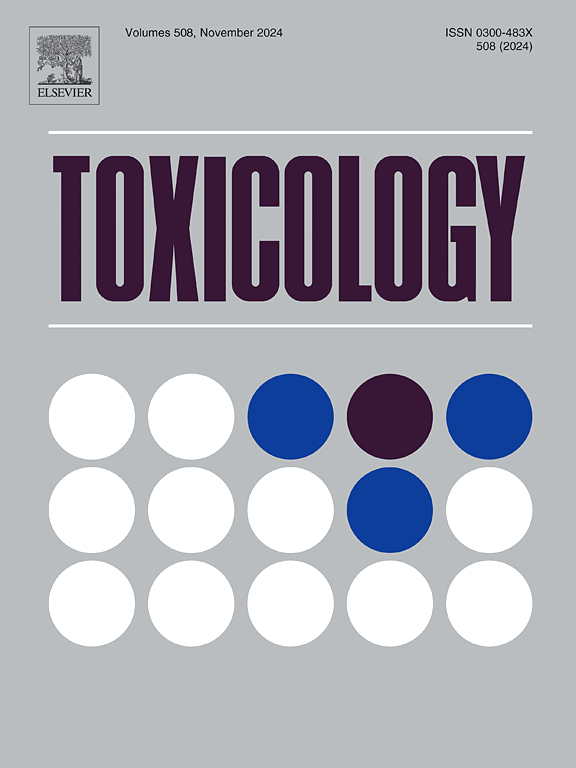Chronic low-level exposure to Pb, Hg, and Cd mixture triggers brain premature aging in rat
IF 4.6
3区 医学
Q1 PHARMACOLOGY & PHARMACY
引用次数: 0
Abstract
Lead (Pb), mercury (Hg), and cadmium (Cd), prevalent neurotoxic heavy metals in the environment, are commonly detected at low concentrations in the blood of the general population. Our previous studies demonstrated that Pb, Hg, and Cd mixture induced neurodevelopmental toxicity even at very low levels. However, the long-term effects of low-level Pb, Hg, Cd exposure on brain aging remain unclear. In this study, female rats were exposed to a mixture of 10 mg/L Pb(CH3COO)2, 0.05 mg/L HgCl2, and 3.5 mg/L CdCl2 via drinking water from mating until offspring weaning. Offspring continued to exposed to heavy metal mixture (3.5 mg/L Pb(CH3COO)2, 0.015 mg/L HgCl2, and 0.5 mg/L CdCl2) for 32 weeks. At 52 weeks of age, brain aging was comprehensively evaluated through behavioral testing, histopathological examination, and telomere assessment. The results revealed that prolonged low-level exposure to the Pb, Hg, and Cd mixture compromised telomeric function by shortening telomere length, inhibiting telomerase activity, and induced neuronal loss in the hippocampal CA1 and CA3 regions. Additionally, Golgi staining revealed disrupted dendritic spines in the hippocampus and altered spine-related signaling pathways (Snk-SPAR pathway). Furthermore, behavioral testing showed that exposure to this mixture impaired spatial memory and social cognition. In conclusion, prolonged exposure to low levels of Pb, Hg, and Cd accelerated brain aging by causing hippocampal telomere dysfunction, neuronal loss, dendritic degeneration, and cognitive decline in rats. These findings offer novel insights into the potential neurotoxic effects of chronic exposure to low-level of Pb, Hg, and Cd mixtures on neurological health.
长期低水平暴露于铅、汞、镉混合物会引起大鼠脑早衰。
铅(Pb)、汞(Hg)和镉(Cd)是环境中普遍存在的神经毒性重金属,通常在普通人群的血液中以低浓度检测到。我们之前的研究表明,即使在非常低的水平,铅、汞和镉的混合物也会引起神经发育毒性。然而,低水平的铅、汞、镉暴露对脑老化的长期影响尚不清楚。在本研究中,雌性大鼠从交配到后代断奶,通过饮用水暴露于10mg/L Pb(CH3COO)2、0.05mg/L HgCl2和3.5mg/L CdCl2的混合物中。子代继续暴露于重金属混合物(3.5mg/L Pb(CH3COO)2、0.015mg/L HgCl2和0.5mg/L CdCl2)中32周。在52周龄时,通过行为测试、组织病理学检查和端粒评估综合评估脑老化。结果显示,长时间低水平暴露于铅、汞和镉混合物中,通过缩短端粒长度、抑制端粒酶活性和诱导海马CA1和CA3区域的神经元丢失,损害了端粒功能。此外,高尔基染色显示海马树突棘被破坏,脊柱相关信号通路(Snk-SPAR通路)发生改变。此外,行为测试表明,暴露在这种混合物中会损害空间记忆和社会认知。综上所述,长期暴露于低水平的铅、汞和镉环境中会导致大鼠海马端粒功能障碍、神经元丧失、树突变性和认知能力下降,从而加速脑衰老。这些发现为长期暴露于低水平的铅、汞和镉混合物对神经系统健康的潜在神经毒性作用提供了新的见解。
本文章由计算机程序翻译,如有差异,请以英文原文为准。
求助全文
约1分钟内获得全文
求助全文
来源期刊

Toxicology
医学-毒理学
CiteScore
7.80
自引率
4.40%
发文量
222
审稿时长
23 days
期刊介绍:
Toxicology is an international, peer-reviewed journal that publishes only the highest quality original scientific research and critical reviews describing hypothesis-based investigations into mechanisms of toxicity associated with exposures to xenobiotic chemicals, particularly as it relates to human health. In this respect "mechanisms" is defined on both the macro (e.g. physiological, biological, kinetic, species, sex, etc.) and molecular (genomic, transcriptomic, metabolic, etc.) scale. Emphasis is placed on findings that identify novel hazards and that can be extrapolated to exposures and mechanisms that are relevant to estimating human risk. Toxicology also publishes brief communications, personal commentaries and opinion articles, as well as concise expert reviews on contemporary topics. All research and review articles published in Toxicology are subject to rigorous peer review. Authors are asked to contact the Editor-in-Chief prior to submitting review articles or commentaries for consideration for publication in Toxicology.
 求助内容:
求助内容: 应助结果提醒方式:
应助结果提醒方式:


